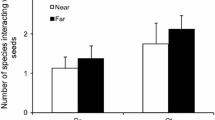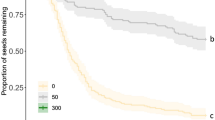Abstract
The five species of seed-harvesting ants at a study site in semi-arid New South Wales comprise the most abundant trophic group of the ant community. These ants and the plant community are described briefly, and areas of potential interaction, which could influence the population dynamics of either community, are defined. A study of these interactions suggests that there are no strong short-term regulatory effects, and that the granivore-plant system is rather loosely coupled. Plant population dynamics are determined primarily by the timing and magnitude of an unpredictable rainfall, with little feed-back effect from seed-harvester activity. The ants do not appear to be limited by seed availability, and a system of buffers within the ant community dampens population fluctuations when food resources change. Such loose coupling within and between trophic levels would tend to stabilize the structure of communities subjected to extreme, variable and unpredictable environments, such as the semi-arid and arid regions of Australia.
Access this chapter
Tax calculation will be finalised at checkout
Purchases are for personal use only
Preview
Unable to display preview. Download preview PDF.
Similar content being viewed by others
References
Bernstein, R. A. & Gobbel, M., 1979. Partitioning of space in communities of ants. Ecology 48: 931–942.
Briese, D. T., 1974. Ecological Studies on an Ant Community in a Semi-arid Habitat (with Emphasis on Seed-harvesting Species). Ph. D. Thesis, A.N.U., 204 pp.
Briese, D. T. & Macauley, B. J., 1977. Physical structure of an ant community in semi-arid Australia. Aust. J. Ecol. 2: 107–120.
Briese, D. T. & Macauley, B. J., 1980. Temporal structure of an ant community in semi-arid Australia. Aust. J. Ecol. 5: 121–134.
Briese, D. T. & Macauley, B. J., 1981. Food collection within an ant community in semi-arid Australia, with special reference to seed harvesters. Aust. J. Ecol. 6: 1–19.
Briese, D. T. & Macauley, B. J., 1981. Resource partitioning among seed-harvesting ants in semi-arid Australia. Aust. J. Ecol. 7:in press.
Briese, D. T. & Macauley, B. J., 1981. The Effect of ants on the soil of a semi-arid saltbush habitat. Insectes So.. 29: in press. Aust. J. Ecol. 6: 1–19.
Brown, J. H., Davidson, D. W. & Reichman, O. J., 1979. An experimental study of competition between seed-eating desert rodents and ants. Am. Zool. 19: 1129–1143.
Brown, W. L. & Taylor, R. W., 1970. Hymenoptera: superfamily Formicoidea. In: CSIRO, The Insects of Australia, 951–959. Melbourne University Press, Melbourne.
Campbell, M. H., 1966. Theft by harvesting ants of pasture seed broadcast on unploughed land. Exp. Agric. Anim. Husb. 6: 334–338.
Davidson, D. W., 1977. Species diversity and community organization in desert seed-eating ants. Ecology 58: 711–724.
Greenslade, P. J. M., 1979. A Guide to Ants of South Australia. South Australian Museum, Adelaide, 44 pp.
Gregg, R. E., 1963. The Ants of Colorado. Univ. Colorado Press, Boulder, 792 pp.
Hall, E. A. A., Specht, R. L. & Eardley, C. M., 1964. Regeneration of the vegetation on Koonamore Vegetation Reserve 1926–62. Aust. J. Bot. 12: 205–264.
Hansen, S. R., 1978. Resource utilization and coexistence of three species of Pogonomyrmex ants in an upper Sonoran grassland community. Oecologia 35: 109–117.
Harper, J. L., 1969. The role of predation in vegetational diversity. Brookhaven Symp. Biol. 22: 48–62.
Harper, J. L. & White, J., 1970. The dynamics of plant popula¬tions. Proc. Adv. Study Inst. Dynamics Numbers Popul. ( Oos- terbeek, 1970 ): 41–63.
Hayashida, K., 1960. Studies on the ecological distribution of ants in Sapporo and its vicinity. Insectes Soc. 7: 125–162.
McGowan, A. A., 1969. Effect of seed-harvesting ants on the persistence of Wimmera rye-grass in northeastern Victoria. Exp. Agric. Anim. Husb. 9: 37–40.
Moore, C. W. E., 1953. The vegetation of the south-eastern River- ina, New South Wales, 2. The disclimax communities. Aust. J. Bot. 1: 548–567.
Morton, S. R., 1979. Diversity of desert-dwelling mammals: a comparison of Australia and North America. J. Mammal. 60: 253–264.
Morton, S. R., 1982. Granivory in the Asuralian arid zone: diversity of harvester ants and structure of their communities. In Baker, W.R. & Greenslade, P. J. M.(eds.). Evolution of the Flora and Fauna of Australia. Peacock. Adelaide in press. . J. Mammal. 60: 253–264.
Noy-Meir, I., 1973. Desert ecosystems: environment and producers. Ann. Rev. Ecol. Syst. 4: 25–51.
Rogers, L. E., 1974. Foraging activity of the western harvester ant in the shortgrass plains ecosystem. Environ. Entomol. 3: 420–424.
Schumacher, A, & Whitford, W. G., 1976. Spatial and temporal variation in Chihuahuan desert ant faunas. Southwest. Nat. 21: 1–8.
Stradling, D. J., 1978. Food and feeding habits of ants. In: Brian, M. V. (ed.), Production Ecology of Ants and Termites, 81–106. C.U.P., Cambridge.
Sudd, J. H., 1967. An Introduction to the Behaviour of Ants. Arnold, London, 200 pp.
Tevis, L., 1958. Interrelations between the harvester ant Veromessor pergandei and some desert emphemerals. Ecology 39: 695–704.
Westoby, M., Cousins, J. M. & Grice, A. C., 1982. Rate of decline of soil seed populations during drought in western New South Wales, this volume.
Whitford, W. G., 1978a. Foraging by seed-harvesting ants. In: Brian, M. V. (ed.), Production Ecology of Ants and Termites, 107–110, C.U.P., Cambridge.
Whitford, W. G., 1978b. Foraging in seed-harvester ants Pogonomyrmex spp. Ecology 59: 185–189.
Williams, D. G., 1972. Ecological Studies on Shrub-steppe of the Western Riverina, New South Wales. Ph. D. Thesis, A.N.U., 166 pp.
Williams, O. B., 1961. Studies in the ecology of the Riverine Plain. III. Phenology of a Danthonia caespitosa Gaudich grassland. Aust. J. Agric. Res. 12: 247–259.
Williams, O. B., 1968. Studies in the ecology of the Riverine Plain. IV. Basal area and density changes of Danthonia caespitosa Gaudich in a natural pasture grazed by sheep. Aust. J. Bot. 16: 565–578.
Wilson, A. D., Leigh, J. H. & Mulham, W. E., 1969. A study of merino sheep grazing a bladder saltbush (A triplex vesiearia) - cotton bush (Kochia aphylla) community on the Riverine Plain. Aust. J. Agric. Res. 20: 1123–1136.
Editor information
Editors and Affiliations
Rights and permissions
Copyright information
© 1982 Dr W. Junk Publishers, The Hague
About this chapter
Cite this chapter
Briese, D.T. (1982). Relationship between the seed-harvesting ants and the plant community in a semi-arid environment. In: Buckley, R.C. (eds) Ant-plant interactions in Australia. Geobotany, vol 4. Springer, Dordrecht. https://doi.org/10.1007/978-94-009-7994-9_3
Download citation
DOI: https://doi.org/10.1007/978-94-009-7994-9_3
Publisher Name: Springer, Dordrecht
Print ISBN: 978-94-009-7996-3
Online ISBN: 978-94-009-7994-9
eBook Packages: Springer Book Archive




